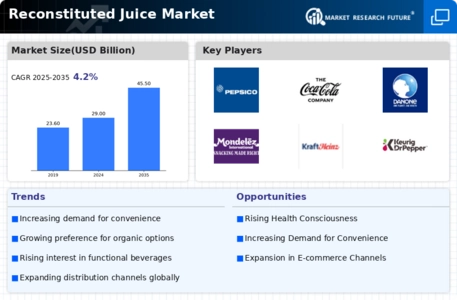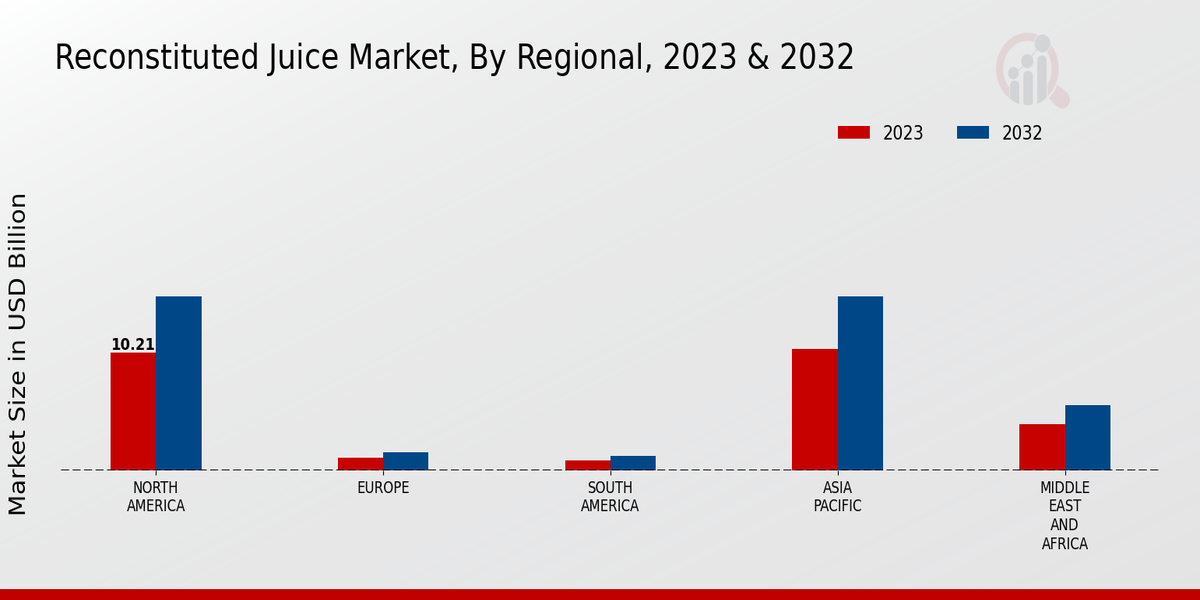Diverse Flavor Profiles
The Global Reconstituted Juice Market Industry is likely to benefit from the increasing variety of flavor profiles available in reconstituted juices. Consumers are becoming more adventurous in their taste preferences, seeking unique blends and exotic flavors. This trend encourages manufacturers to experiment with combinations that appeal to a broader audience. The introduction of innovative flavors may attract younger demographics, thereby expanding the consumer base. As the market evolves, the ability to offer diverse and appealing options could be a key factor in driving growth and maintaining competitiveness.
Market Growth Projections
The Global Reconstituted Juice Market Industry is projected to experience substantial growth, with estimates indicating a rise from 29.0 USD Billion in 2024 to 45.5 USD Billion by 2035. This growth trajectory suggests a compound annual growth rate (CAGR) of 4.18% from 2025 to 2035. Such projections reflect the increasing consumer demand for reconstituted juices, driven by health trends, convenience, and flavor diversity. As the market expands, stakeholders may focus on strategic investments and innovations to capture emerging opportunities, thereby enhancing their market presence.
Rising Health Consciousness
The increasing awareness of health and wellness among consumers appears to be a significant driver for the Global Reconstituted Juice Market Industry. As individuals prioritize healthier lifestyles, the demand for nutritious beverages, including reconstituted juices, is likely to rise. This trend is reflected in the projected market value of 29.0 USD Billion in 2024, with consumers seeking products that offer essential vitamins and minerals. The shift towards natural ingredients and the avoidance of artificial additives further bolster this demand, as consumers become more discerning about their beverage choices.
Convenience and On-the-Go Consumption
The fast-paced lifestyle of modern consumers seems to be influencing the Global Reconstituted Juice Market Industry, as convenience becomes a priority. Reconstituted juices, often available in portable packaging, cater to the need for quick and easy nutrition. This trend is particularly evident among busy professionals and health-conscious individuals who prefer ready-to-drink options. The market's projected growth to 45.5 USD Billion by 2035 indicates a strong potential for products that align with this demand for convenience, suggesting that manufacturers may focus on innovative packaging solutions to enhance accessibility.
Technological Advancements in Production
Technological innovations in production processes seem to be shaping the Global Reconstituted Juice Market Industry. Advances in extraction and preservation techniques allow for better retention of nutrients and flavors, enhancing the overall quality of reconstituted juices. This could lead to increased consumer satisfaction and loyalty, as products become more appealing. Furthermore, the implementation of automation and efficiency improvements in manufacturing may reduce costs, potentially allowing for competitive pricing. As the market evolves, companies that leverage these technological advancements may position themselves favorably in a growing industry.
Sustainability and Eco-Friendly Practices
Sustainability appears to be a growing concern among consumers, influencing their purchasing decisions in the Global Reconstituted Juice Market Industry. As environmental awareness rises, brands that adopt eco-friendly practices, such as sustainable sourcing and recyclable packaging, may gain a competitive edge. This trend aligns with the increasing demand for transparency in product sourcing and production methods. Companies that prioritize sustainability could potentially attract a loyal customer base, as consumers are more inclined to support brands that align with their values. This shift may also lead to innovations in production processes that reduce environmental impact.

















